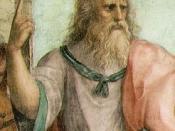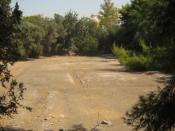Plato
(428 B.C--347B.C)
Plato was born in 428 B.C to Ariston, a descendent from early kings of Athens, and Perictione, a distant relative of the 6th century lawmaker Solon. He was a Greek philosopher. Throughout his life, in his Academy, he educated those who would become some of the most influential mathematicians and philosophers. Plato's many contributions to modern mathematics include the founding of the Academy of Athens, method of philosophical problem solving, and his Theory of Forms.
In 387, he founded the Academy of Athens, the first European university, which became the intellectual center of Greece for over nine hundred years. Over the main entrance to the university was the phrase, "Let No One Un-versed in Geometry Enter." Those who studied at Plato's Academy made most of the major mathematical innovations of the 4th century. Plato was an avid philosopher and mathematician. He taught courses including arithmetic, theory of numbers, advanced geometry, and astronomy through technical lectures with abstract and philosophical leanings.
Plato's teaching and problem-solving methods were the foundations, in his time, of forward thinking. He consciously transferred the mode of mathematical argument to that of philosophical argument and back with stunning success to further stimulate original and substantial thoughts and developments in his students. Some of the many innovators associated with the academy, including; Theaetetus, Eudoxus, and Archytas, are thought to have had a hand in the writing of Euclid's Elements. Plato himself made many important contributions to mathematics as well.
Plato produced the theory of Forms. We use this today, in modern geometrical mathematics.
"A circle is defined as a plane figure composed of a series of points, all of which are equidistant from a fixed point. No one has actually seen it. When mathematicians define a circle, the points referred to are not spatial points;...



My thoughts on this essay
I thought this essay was very rough. It has a lot of short and choppie sentences. It did not flow correctly. This author needs to learn what a fragmented sentence is. Please look into getting a bbok like The Little, Brown Handbook. It will help you a great deal when you reach college English.
1 out of 1 people found this comment useful.